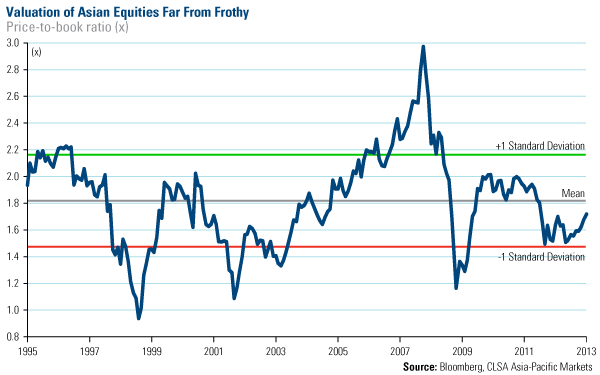Emerging Markets Radar (January 6, 2013)
Strengths
- Dedicated emerging market funds registered another $3.37 billion of inflows for the week ending Wednesday, January 2, marking the 17th consecutive week of positive money influx. Since the Fed’s announcement of QE3, $37 billion has flown into emerging market funds cumulatively.
- China’s privately compiled HSBC Manufacturing PMI rose to a much better than expected 51.5 in December from 50.5 in November, highlighting a robust ongoing trend of strengthening industrial activity in the country.
- Hong Kong reported a better than expected 9.5 percent year-over-year retail sales growth for November, as jewelry and luxury goods sales made a strong recovery thanks to a 30 percent surge in Chinese visitor arrivals in the month from a year earlier.
- Macau announced record casino-gaming revenues of 28.2 billion pataca ($3.5 billion) for December, representing 20 percent growth year-over-year and 14 percent month-over-month, due to continued recovery in the VIP market especially after the leadership transition in mainland China.
Weaknesses
- Singapore’s Manufacturing PMI deteriorated to a lower than expected 48.6 in December from 48.8 in November, a sixth-consecutive month in contraction, driven by weak electronics demand.
- India’s current account deficit rose to a record high of 5.4 percent of GDP in the third quarter of 2012 from 3.9 percent in the second quarter, because of weaker exports and higher gold imports.
- Indonesia’s trade balance remained in deficit in November at $0.5 billion, albeit smaller than October’s $1.9 billion. In 2012, the country turned from a net oil exporter to net oil importer due to declining oil production and rising domestic demand aggravated by fuel subsidies.
- South Korea’s exports in December declined 8.8 percent year-over-year, worse than market expectations of a 0.8 percent gain, affected by fewer work days related to its presidential election.
Opportunities
- Despite the recent rise in Asian equities driven by improved sentiment towards China and associated fund inflows, their valuations are far from frothy levels. Measured by trailing price-to-book ratio, Asian equities are trading at around 1.7 times, compared with an 18-year average of about 1.8 times. Plenty of room remains for a further re-rating of valuations, if corporate fundamentals continue to improve.

Threats
- Increasing chatter about a return of pricing power for Chinese property developers in 2013 may bring back the specter of more government policy tightening towards the sector, as lower inventory levels, slower new construction starts, and declining land sales in 2012 put pressure on housing supply this year.












